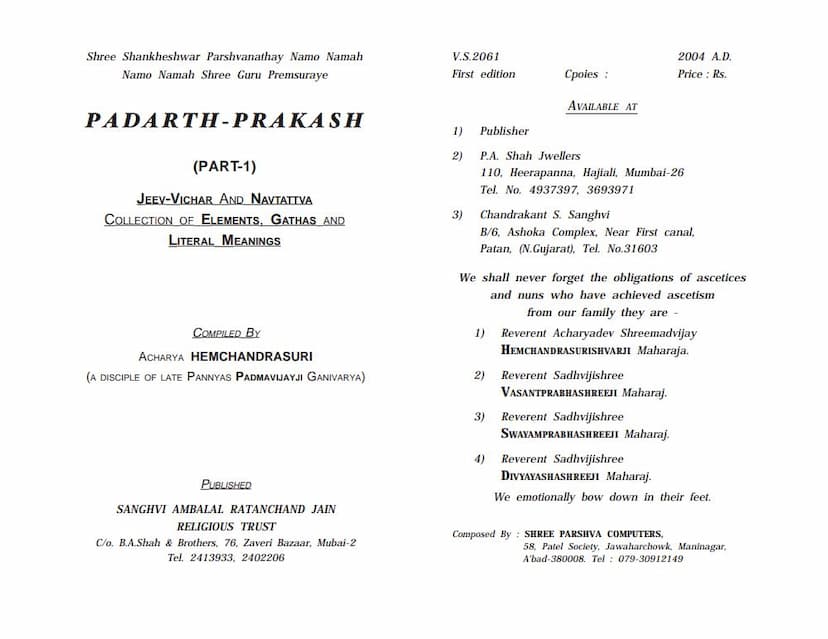Jiva Vichar
Added to library: September 2, 2025

Summary
This document is an English translation of "Jeev Vichar" and "Navtattva" by Acharya Hemchandrasuri, published by Sanghvi Ambalal Ratanchand Jain Dharmik Trust. The book serves as a foundational text for understanding core Jain principles.
Jeev Vichar (Discussion on Living Beings)
This section meticulously categorizes and explains the diverse forms of living beings (Jeev) in Jain cosmology.
- Fundamental Division: The universe is divided into two primary categories: Jeev (living beings) and Ajeev (non-living beings).
- Two States of Jeev:
- Sansari: Beings bound by karma, continuously cycling through the mundane world.
- Siddh: Souls that have attained liberation from the cycle of birth and death.
- Types of Sansari Beings:
- Sthavar (Immobile): Living beings that cannot move from one place to another. These are further categorized into five types based on their primary element:
- Prithvikaay: Earth-bodied beings (e.g., stones, metals).
- Apkaay: Water-bodied beings (e.g., water, ice).
- Teukaay: Fire-bodied beings (e.g., sparks, flames).
- Vaukaay: Air-bodied beings (e.g., wind).
- Vanaspatikaay: Vegetation-bodied beings, further divided into:
- Pratyek: One soul per body (e.g., trees, fruits).
- Sadharan: Infinite souls per body (e.g., onions, sprouts).
- Tras (Mobile): Living beings capable of voluntary movement. These are categorized based on the number of sense organs they possess:
- Beindriya (Two-sensed): Possess touch and taste (e.g., worms).
- Teindriya (Three-sensed): Possess touch, taste, and smell (e.g., ants).
- Chaurindriya (Four-sensed): Possess touch, taste, smell, and sight (e.g., scorpions, bees).
- Panchendriya (Five-sensed): Possess all five senses. These are further divided into:
- Tiryanch (Sub-human): Animals, birds, aquatic life, etc., further classified as Jalchar (aquatic), Sthalchar (terrestrial), and Khechar (aerial). They can be Garbhaj (born from womb) or Sammurchhim (naturally born).
- Manushya (Human beings): Dwell in specific regions of the universe.
- Dev (Celestial beings): Inhabit various heavens.
- Naarki (Infernal beings): Reside in hellish realms.
- Sthavar (Immobile): Living beings that cannot move from one place to another. These are further categorized into five types based on their primary element:
- Paryapti and Aparyapti: Living beings are also classified as Paryapta (those who have completed the necessary stages of development for their body type) and Aparyapta (those who die before completing these stages).
- Body Types: The text describes five types of bodies: Audaarik (gross body), Vaikriya (transformable body), Aahaarak (embodying desire for food), Taijas (fiery body), and Karman (karmic body).
- Cosmology: A detailed description of the Jain universe (Lok) is provided, including the arrangement of Jambudweep, surrounding oceans and islands, and the division into Urdhvalok (upper world), Adholok (lower world), and Tirchhalok (middle world).
- Lifespan, Body Height, and Pranas: The text outlines the lifespans, body dimensions, and vitalities (Pranas - sense organs, powers, respiration, life) of various beings.
- Yonis (Reproductive Places): The 84 lakh yonis are described, categorizing the different places where various beings are born.
Nav-Tattva (Nine Elements)
This section explains the nine fundamental principles or categories of reality according to Jainism, essential for understanding the path to liberation.
- Jeev: The sentient soul, possessing consciousness, knowledge, and the capacity for experiencing happiness and suffering. It is the subject of all experiences.
- Ajeev: Non-sentient substances, comprising:
- Dharmastikaay: The principle of motion.
- Adharmastikaay: The principle of rest.
- Akashastikaay: Space.
- Kaal: Time.
- Pudgalastikaay: Matter (possessing color, odor, taste, touch).
- Punya: Karmic matter that leads to merit, happiness, and favorable rebirths.
- Paap: Karmic matter that leads to demerit, suffering, and unfavorable rebirths.
- Aashrav: The influx of karmic particles into the soul, caused by sensory activities, passions, and vows.
- Samvar: The cessation of karmic influx, achieved through self-restraint, proper conduct, and ascetic practices.
- Bandh: The bondage of karmic particles to the soul, occurring when Aashrav is present.
- Nirjara: The shedding of accumulated karma from the soul, achieved through penance and austerities.
- Moksha: Liberation of the soul from all karmic bondage, resulting in its pure, omniscient, and blissful state.
The book further elaborates on the subtypes and classifications within each of the nine tattvas, providing detailed explanations, similes, and scriptural references. It emphasizes the importance of understanding these tattvas for developing right faith (Samyaktva) and progressing on the spiritual path towards liberation. The text concludes by stressing that true understanding and practice of these principles lead to the ultimate goal of Moksha.